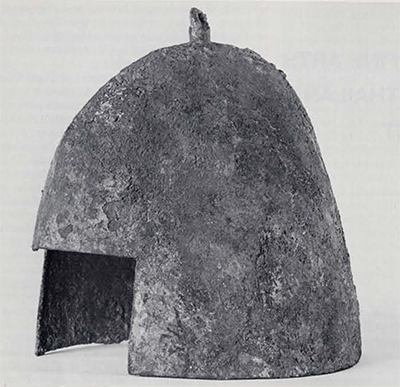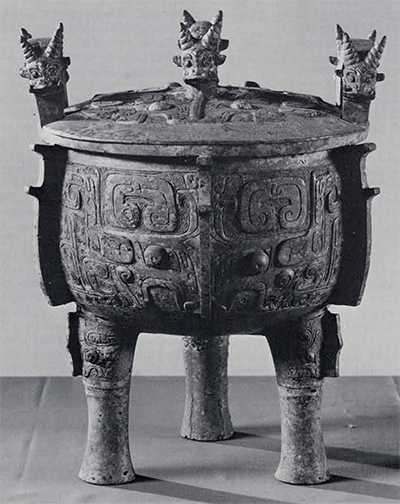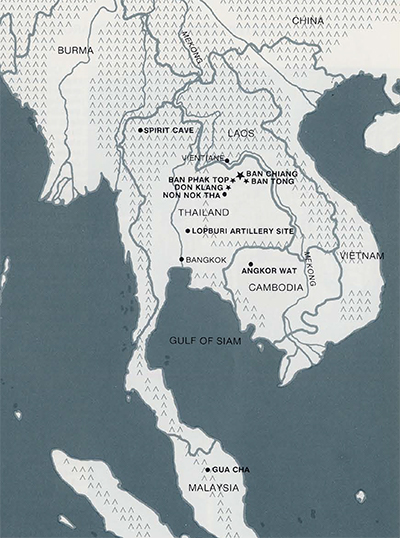 In this issue of Expedition, designed to be some small tribute to Froelich Rainey for his many years of inspired leadership as director of the University Museum of the University of Pennsylvania, we have the special privilege of publishing three articles dealing with recent archaeological work in northeastern Thailand, especially with material from the sites of Non Nok Tha and Ban Chiang. The cooperative arrangement under which this work is being conducted is described in the article by Chester Gorman and Pisit Charoenwongsa. The purpose of this brief editorial note is to introduce the reader to the historical questions raised by the discoveries in Thailand and to give some indication why the University Museum attaches such importance to its present work there.
In this issue of Expedition, designed to be some small tribute to Froelich Rainey for his many years of inspired leadership as director of the University Museum of the University of Pennsylvania, we have the special privilege of publishing three articles dealing with recent archaeological work in northeastern Thailand, especially with material from the sites of Non Nok Tha and Ban Chiang. The cooperative arrangement under which this work is being conducted is described in the article by Chester Gorman and Pisit Charoenwongsa. The purpose of this brief editorial note is to introduce the reader to the historical questions raised by the discoveries in Thailand and to give some indication why the University Museum attaches such importance to its present work there.
It is not often that archaeological discoveries are described in feature stories in major newspapers and magazines around the country. Yet, for the past year, the finds from Ban Chiang have been discussed in articles appearing in the New York Times, the Washington Post, Newsweek and Time. All of these articles have repeated the same basic claim, that the finds from Ban Chiang provide the earliest bronze yet discovered and suggest that the Bronze Age might have first begun in Southeast Asia. The reader might well ask, so what? Who cares about the Bronze Age anyway!
The point is that we are not just talking about where and how ancient man learned to make an alloy of copper and tin. What is involved here is the nature of one of the basic advances in man’s technology and the challenge to a long-cherished paradigm of historical development that now emerges from the discoveries in Thailand. For several generations now, the priority of ancient Mesopotamia (modern Iraq) in cultural and technological development has been accepted by all students of prehistory. The art of writing, the making of bronze and the growth of urban centers protected by fortification walls were all developments thought of as originating and spreading from there to other parts of the ancient world.
So pervasive was this point of view that, when the excavations by the Academia Sinica at the site of Anyang in the northern part of Honan province, China, first revealed the rich bronze metallurgy of the Shang Dynasty (c 1600-1027 B.C.), it was assumed by scholars working on the material that bronze metallurgy could not have had an independent origin in China but must have been brought in from the outside. In spite of the very special nature of Chinese bronze metallurgy, seemingly derived from the art of the potter and using a unique technique of piece-mould casting, it was felt that the basic technology of making and casting bronze must have developed somewhere outside of China, perhaps in the Ancient Near East. There were two basic reasons for accepting this argument:
- The material from Anyang was no earlier than c 1300 B.C., the site being the capital only in the final period of the Shang Dynasty. Bronze in Mesopotamia went back as early as c 3000 B.C.
- The bronzes from Anyang were of a sophisticated style that must have taken years to develop, yet no antecedents were known from China itself. The Academia Sinica excavated at Anyang from 1928 to 1937, but for years thereafter Anyang Bronzes were the earliest evidence for copper or bronze metallurgy from anywhere in Southeast Asia or East Asia. Again, the contrast with Mesopotamia was instructive, for there a complete sequence of technology was being reconstructed, from the simple use of native copper to the complexities of lost-wax bronze casting.
China was important for it was also held that, once bronze metallurgy developed there, it spread from China to other parts of the East. This meant that bronze metallurgy came to Thailand no earlier than the early first millennium B.C. Compare this to the date of c. 3600 B.C. now proposed for a bronze spearhead from Ban Chiang and you have some idea of the magnitude of the challenge to traditional theory now underway.
 The revolution in prehistory, affecting not only Southeast Asia and East Asia but all of the ancient world, is based not only upon new discoveries from recent excavations but also upon new techniques of dating. Radiocarbon (C-14) dating of organic material and thermoluminescence dating of fired clay have provided the prehistorian with independent scientific dating techniques. All too often in the past, the dating of material from parts of the world without early historical traditions was based upon an assumed relationship with similar material known from the literate world, from the Ancient Near East or from Egypt. Radiocarbon dating has suggested that the resulting scheme, built up with great detail and precision over a long period of time, is quite fallacious and in need of total revision. This is what Colin Renfrew calls the ‘Radiocarbon Revolution’ and its effects upon European prehistory have been quite spectacular.
The revolution in prehistory, affecting not only Southeast Asia and East Asia but all of the ancient world, is based not only upon new discoveries from recent excavations but also upon new techniques of dating. Radiocarbon (C-14) dating of organic material and thermoluminescence dating of fired clay have provided the prehistorian with independent scientific dating techniques. All too often in the past, the dating of material from parts of the world without early historical traditions was based upon an assumed relationship with similar material known from the literate world, from the Ancient Near East or from Egypt. Radiocarbon dating has suggested that the resulting scheme, built up with great detail and precision over a long period of time, is quite fallacious and in need of total revision. This is what Colin Renfrew calls the ‘Radiocarbon Revolution’ and its effects upon European prehistory have been quite spectacular.
The resulting situation in China and Thailand is of special interest here. Recent archaeological work in China has received great publicity these past few years. For bronze metallurgy the important sites are that of Erh-li-t’ou in west-central Honan Province, a site that may be that of the capital city of the founder of the Shang Dynasty, and at Chengchou, south of Anyang, the site of ancient Ao, the capital city of Chung-ting, the tenth king of the Shang Dynasty. Here bronzes have been found that are both earlier and cruder than those from Anyang. The first radiocarbon dates from Mainland China suggest that copper metallurgy in China could be as old as c 2000 B.C. But no earlier, at least on the evidence now available. Yet the radiocarbon dates indicate the presence of bronze in northern Thailand some 1500 years earlier.

This suggests a situation exactly the reverse of that outlined above. Perhaps bronze metallurgy actually came from Thailand to China. That is exactly what has now been claimed, but on philological rather than archaeological grounds. Paul Benedict, the author of what is known as the ‘Benedict Hypothesis’ has proposed that the basic agricultural and metallurgical terminology in Chinese actually comes from what he calls the Austro-Thai language family. According to Benedict, the word for copper, Chinese t’ung, was borrowed by the Chinese from AustroThai. For Benedict the graves at Ban Chiang and Non Nok Tha represent “the very graves of these ancestral Austro-Thai people or peoples, with evidence of sophisticated bronze casting in the middle of the third millennium B.C., about a thousand years before the appearance of the celebrated bronzes of ancient China.
At the same time, students of ancient Chinese metallurgy now place great emphasis upon the independent invention of metallurgy in China itself. Recent studies have been totally opposed to any possibility of diffusion or borrowing from outside China, be it from western Asia or even Thailand. China had its own sources of copper and tin, and a country that invented gunpowder, the compass and the art of printing was quite capable of developing its own metallurgy. So the argument goes, and all indications are that we are in for a lively discussion in the years ahead.
